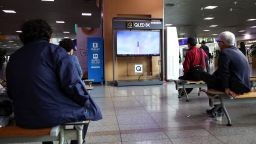Japan urged residents to take shelter early Tuesday morning after North Korea fired a ballistic missile without warning over the country for the first time in five years, in a major and potentially dangerous escalation of recent weapons tests by the Kim Jong Un regime.
The launch, which prompted immediate backlash from Tokyo and Seoul, comes amid a spate of missile tests, with five launches in the past 10 days, and follows renewed military drills between the United States and its regional allies.
The intermediate-range missile was launched from Mupyong-ri near North Korea’s central border with China at around 7:23 a.m. local time, according to South Korea’s Joint Chiefs of Staff (JCS). It flew about 4,600 kilometers (2,858 miles) for 20 minutes at an estimated maximum altitude of 1,000 kilometers (621 miles) over Japan’s Tohoku region on the main island of Honshu before falling into the Pacific Ocean, some 3,000 kilometers (1,864 miles) from the country’s shore, Japanese officials said.
Japanese Prime Minister Fumio Kishida strongly condemned the launch and called North Korea’s recent ballistic missile launches “outrageous” in comments to reporters at his official residence.
Tuesday’s launch is the country’s 23rd such missile test this year, including both ballistic and cruise missiles.
There were no reports of damage to aircraft or vessels near the missile trajectory, according to Japanese authorities, but the unannounced missile triggered a rare J-alert, a system designed to inform the public of emergencies and threats in Japan.
In such emergencies, alerts are sent out via sirens, through community radio stations and to individual smartphone users. On Tuesday, alerts were sent out at around 7:30 a.m. local time to people in Aomori prefecture, Hokkaido and Tokyo’s Izu and Ogasawara islands, according to Japanese officials.
A tweet posted by Japan’s Prime Minister’s office urged residents to take shelter in buildings and to “not approach anything suspicious that is found and to immediately contact the police or fire department.”
South Korea, US condemn missile launch
Other governments were quick to decry the launch, with South Korea’s President Yoon Suk Yeol branding it a “reckless” provocation, adding that North Korea will face a decisive response from the South Korean military and its allies.
The White House also “strongly condemned” the test, with National Security Council spokesperson Adrienne Watson calling it a “destabilizing” action that shows North Korea’s “blatant disregard for United Nations Security Council resolutions and international safety norms.”
Kim Seung-kyum, chief of South Korea’s Joint Chiefs of Staff (JCS), and Paul LaCamera, the United States Forces Korea commander, held a meeting after the launch and reaffirmed the combined defense posture will be further strengthened against any threats and provocations from North Korea, the JCS said.
The US Indo-Pacific Command also released a statement saying American commitments to the defense of Japan and South Korea “remain ironclad.”
Ankit Panda, a senior fellow in the Nuclear Policy Program at the Washington-based Carnegie Endowment for International Peace, said regular missile testing was was part of North Korea’s plan to maintain its nuclear forces.
“It is quite possible that the United States, South Korea and Japan will take away a message from this missile test that North Korea is continuing to assert itself to show that it has the ability to deliver nuclear weapons to targets including the US territory of Guam,” he said, adding that “risk reduction” to stop a crisis from escalating should be the current priority.
“If such a crisis were to play out, it would play out under a significantly more advanced North Korean nuclear capability, which I think would significantly limit the options that the United States and South Korea would have, potentially to retaliate or manage escalation with North Korea,” he said.
North Korea’s potential nuclear plans
Tuesday’s launch could herald an intensification of provocations by North Korean leader Kim Jong Un, experts told CNN.
“Pyongyang is still in the middle of a provocation and testing cycle and is likely waiting until after China’s mid-October Communist Party Congress to conduct an even more significant test,” said Leif-Eric Easley, associate professor of international studies at Ewha Womans University in Seoul.
“The Kim regime is developing weapons such as tactical nuclear warheads and submarine-launched ballistic missiles as part of a long-term strategy to outrun South Korea in an arms race and drive wedges among US allies.”
Four previous missile launches occurred in the space of a week in late September and early October, around the same time US Vice President Kamala Harris made an official visit to Japan and South Korea, and as US, Japanese and South Korean navies held joint exercises.
North Korea’s tests also come as international attention remains firmly focused on Russia’s invasion of Ukraine – and as both Moscow and Beijing appear reluctant to side with the West to further censure Pyongyang.
In May, Russia and China vetoed a US-drafted United Nations Security Council resolution to strengthen sanctions on North Korea for its weapons testing, in a vote the US said was likely to fuel Pyongyang’s program to develop nuclear-capable missile systems.
Washington and the International Atomic Energy Agency have both warned this year that North Korea may be preparing for a nuclear test, which would be its first since 2017.
Jeffrey Lewis, director of the East Asia Nonproliferation Program at the Middlebury Institute, drew a connection between the missile tests and a potential nuclear test.
“North Korea is going to keep conducting missile tests until the current round of modernization is done. I don’t think a nuclear (test) explosion is far behind,” he told CNN.
CNN’s Jake Kwon and Eric Cheung contributed to this report.
World - Latest - Google News
October 04, 2022 at 01:35PM
https://ift.tt/f0Lce1J
Japan issues rare alert as North Korea fires missile without warning over island - CNN
World - Latest - Google News
https://ift.tt/kzgDSfa



No comments:
Post a Comment